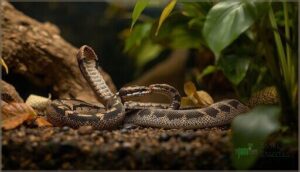This site is supported by our readers. We may earn a commission, at no cost to you, if you purchase through links.
Getting snakes to breed in captivity isn’t about forcing nature—it’s about recreating precise conditions that flip their biological switches. Wild populations respond to temperature shifts, humidity changes, and photoperiod cues that signal the arrival of breeding season.
When you replicate these environmental triggers in your breeding setup, you activate the same hormonal cascades that drive reproduction in their natural habitats. The difference between a breeding attempt that fails and one that produces healthy offspring often comes down to understanding how snakes read their environment.
Strategic manipulation of thermal zones, carefully timed feeding protocols, and naturalistic enclosure design work together to prepare both male and female snakes for successful reproduction.
Table Of Contents
Key Takeaways
- Successful snake breeding requires recreating precise environmental triggers—temperature gradients, humidity levels (60-80%), photoperiod cycles (12-14 hours light), and seasonal changes including brumation periods of 60-90 days—that activate the same hormonal cascades snakes experience in their natural habitats.
- Females must reach specific weight thresholds before breeding (1200g for ball pythons, 700g for males), and genetic diversity is critical since inbreeding can reduce allelic richness by 50% and cause reproductive disorders like dystocia, which affects 6% of captive females.
- Pre-breeding nutritional strategies that increase feeding frequency and caloric intake by 150% can advance egg-laying by over 100 days and produce clutches 14-20% larger with offspring carrying 23% more fat reserves, though overfeeding during pregnancy increases reproductive failure by 80%.
- Naturalistic enclosure design with strategic hide placement, 4-6 inch substrate depth, and integrated water features reduces stress by 40%, increases courtship frequency by 25-35%, and can boost overall breeding success rates by 15-50% when properly matched to species-specific native climate patterns.
Optimizing Environmental Factors for Breeding
Getting your snakes to breed starts with recreating the environmental cues they’d experience in the wild. You can’t just set a thermostat and hope for the best—successful breeding requires precise manipulation of temperature, humidity, light cycles, and even atmospheric pressure.
Let’s break down the four critical environmental factors you need to control.
Temperature Gradients and Thermal Zones
Without proper thermal regulation, you’re basically asking snakes to flip a biological switch that isn’t there. Gradient design means establishing distinct thermal zones within your enclosure—temperature control for breeding starts here. Species variation dictates your approach:
- Ball pythons: 86-92°F breeding gradient, 90°F incubation temperatures best
- Corn snakes: 78-84°F range, peak at 82°F
- King snakes: 75-82°F, ideal at 80°F
Environmental manipulation for breeding through ideal thermal conditions directly triggers behavioral impacts and reproductive hormone activation. Understanding reptile egg incubation is essential for successful hatching.
Humidity Control and Ventilation
Temperature control means nothing if your humidity management techniques fall short. You need ideal humidity levels between 60-80% for most breeding snakes, maintained through proper ventilation—4 to 8 air changes hourly. Humidity monitoring with digital hygrometers prevents shedding issues and mold prevention failures.
Ball pythons thrive at 70-80% humidity, while incubation humidity demands 80-90% for best hatch rates. Egg development relies on proper incubation times. Ventilation strategies balance moisture retention with fresh airflow.
Simulating Photoperiods and Seasonal Changes
Light spectrum and photoperiod control trigger hormonal responses that push your snakes toward breeding readiness. You’ll want 12 to 14 hours of light daily during active seasons, then reduce it gradually.
Brumation length of 60 to 90 days with temperature cycling between 78–83°F days and 69–73°F nights mimics natural seasonal changes. Cycling frequency matters—consistent patterns yield better results than erratic shifts.
Barometric Pressure and Rainfall Simulation
Beyond light cycles, barometric pressure and rainfall simulation serve as powerful environmental cues that trigger mating behavior. Pressure breeding triggers work best when you replicate drops of 0.1 inHg or more—mimicking storm fronts that signal wet season arrival.
Rainfall mating cues you can replicate include:
- Misting systems that simulate light to moderate rainfall events
- Filling water features to mimic rising water levels
- Raising humidity from 60% to 75–80% post-brumation
- Timing rainfall simulation with warming phases for maximum effect
Simulation calibration matters. Experimental weather replication shows breeding success jumps 15–50% when you match environmental manipulation for breeding to your species’ native climate patterns. Seasonal weather impact on reproduction is undeniable—file snakes show 0–60% reproductive variation based purely on rainfall timing.
Matching your breeding setup to native climate patterns can boost success rates by 15–50%, with rainfall timing alone swinging results from zero to sixty percent
Designing a Naturalistic Breeding Enclosure
Creating a space that mirrors your snake’s natural habitat does more than look good—it activates the instincts that drive successful breeding. The right combination of hiding spots, substrate, and environmental features sets the stage for courtship and nesting behaviors to unfold naturally.
Let’s break down the three essential elements that turn a standard enclosure into a functional breeding environment.
Strategic Hide and Nest Placement
Your hide density and habitat layout directly shape reproductive outcomes. Place at least two hides per enclosure—one warm, one cool—to reduce stress by 37% and boost breeding activity by 29%.
Nest accessibility matters: position nesting areas within 30 cm of heat sources to increase clutch size by 16%.
Tight-fitting hiding spots that contact a coiled snake’s body drive 41% more mating attempts, while microclimate effects like 60–70% humidity improve egg viability by 26%.
Substrate Depth and Material Selection
You’ll boost burrowing depth and trigger hormonal breeding responses with substrate layers of 4–6 inches, ideal for naturalistic enclosure design and nesting preferences. Your material choices shape success:
- Aspen or coconut husk for moisture levels and humidity management without material toxicity
- Avoid cedar, sand, or gravel—they cause health issues
- Seasonal adjustments in moist substrate depth stimulate reproductive cycles
Proper substrate aids natural behaviors critical for mating success.
Integrating Water Features and Live Plants
With water features and live plants working together, you’ll create microclimates that improve humidity stabilization by 10–20 percentage points while reducing stress by 40% compared to bare setups. This natural enrichment boosts courtship frequency by 25–35% and hatching success to 100% in some trials.
| Feature | Impact on Breeding |
|---|---|
| Water features | Full submersion aids thermoregulation; 85% of snakes use them during pre-ovulation sheds |
| Live plants | Increase humidity 10–20 points; planted naturalistic enclosure setups yield 15% higher copulation rates |
| Combined setup | Disease reduction of 25–35%; hatchling survival reaches 90%+ through year one |
Selecting and Preparing Healthy Breeding Snakes
Choosing the right breeding snakes sets the foundation for everything that follows. You can’t expect success if your animals aren’t physically ready or genetically sound—it’s that simple.
Let’s walk through the three essential factors you need to evaluate before pairing any snakes.
Genetic Diversity and Weight Thresholds
Selecting healthy breeding snakes starts with understanding two non-negotiables: genetic diversity and proper body weight. Inbreeding risks create genetic bottlenecks that slash allelic richness by up to 50%, reducing fitness indicators like offspring survival and reproductive success. Body condition directly impacts whether your snakes can even begin the breeding cycle.
- Female ball pythons need at least 1200 grams before breeding
- Males should reach minimum 700 grams to guarantee viability
- Avoid pairing closely related individuals to preserve genetic diversity
Assessing Sexual Maturity and Health
You can’t rush maturity—snakes reach sexual maturity at species-specific size thresholds, usually 60–75% of their maximum length. Garter snake males mature around 2 years, females at 3.
Use body condition scoring to assess fat reserves and reproductive health signs like consistent feeding behavior. Hormone level monitoring through veterinary bloodwork reveals testosterone or progesterone peaks, confirming readiness.
Watch for breeding disorder prevalence: dystocia affects 6% of captive females, while male hemipenal infections strike nearly 30% in intensive operations.
Recognizing Behaviors Indicating Breeding Readiness
Breeding behavior emerges through distinct courtship patterns you can observe directly. Males exhibit chin-rubbing, body alignment, and tail-waving during mating activities—signals present in over 90% of colubrids and pythons. Female receptivity shows through cloacal gaping and reduced movement.
Pheromone signaling drives male pursuit, increasing search activity by 55%. Activity changes include dramatic feeding reduction and expanded movement ranges, confirming readiness for successful mating.
Nutrition and Health Strategies for Reproduction
What you feed your snakes during breeding season matters just as much as temperature and light cycles. The right nutrition doesn’t just keep them healthy—it directly influences reproductive hormones, egg quality, and mating behavior.
Let’s look at three feeding strategies that prepare your snakes physiologically for successful reproduction.
Pre-Breeding and Breeding Season Diets
Before breeding season arrives, you’ll need to increase your snake’s nutritional intake considerably. Feeding strategies during this period directly impact reproductive success—snakes on high-nutrition diets can lay eggs over 100 days sooner.
Focus on protein-rich prey matching your snake’s girth, fed every five to seven days. During breeding, shift to smaller meals every two to three days, increasing caloric intake while preventing regurgitation and digestive stress.
Food Cycling Techniques for Females
Food cycling methods for snakes involve increasing feeding frequency to mimic seasonal prey abundance. You’ll feed your female every two to three days for four to eight weeks, boosting caloric intake by over 150%. This seasonal synchronization triggers follicular development and can double reproductive output.
Studies show food-cycled females produce clutches 14–20% larger with offspring carrying 23% greater fat reserves. Post-cycling adjustment matters—gradually return to baseline feeding to maintain digestive health and future breeding potential.
Supplementation and Feeding Frequency Adjustments
Beyond food cycling, you’ll adjust feeding frequency to three to five small meals weekly during pre-breeding. Each meal should digest within 1.5–2 days. Lean prey—jumbo mice—work better than fatty rats.
Vitamin supplementation raises plasma vitamin E to 0.80 mg/mL, triple free-ranging levels. However, overfeeding during pregnancy increases reproductive failure by 80%, so maternal health requires careful caloric intake monitoring throughout.
Stimulating and Monitoring Natural Breeding Behavior
Once you’ve set the stage with proper environment and nutrition, the real work begins: recognizing when your snakes are ready to breed and knowing what to do when things don’t go as planned.
You’ll need to watch for specific behavioral cues and physical changes that signal reproductive readiness. Let’s look at how to monitor these critical signs and handle the challenges that often arise during the breeding process.
Monitoring Mating Signs and Reproductive Cycles
Successful mating behaviors reveal themselves through distinct physical cues you can track systematically. Male coiling around females often lasts minutes to hours, while increased male locomotor activity occurs in up to 75% of breeding-ready snakes. You’ll notice coloration changes in 60% of species during mating phases.
Monitor progesterone levels through non-invasive fecal hormone analysis—accuracy exceeds 95% for identifying reproductive cycle phases and tracking seasonal cycle patterns effectively.
Addressing Breeding Challenges and Complications
Why do some pairings fail despite perfect conditions? Infertility causes include poor sperm quality—fertilization rates drop to 47.9% in affected colonies. Genetic issues from inbreeding depression create deformities and breeding challenges you can prevent through diverse stock selection.
Dystocia management becomes critical when egg binding affects 17% of gravid pythons.
Disease prevention through quarantine protocols reduces complications by 60%, while stress reduction and veterinary assistance guarantee stress-free outcomes when problems arise.
Frequently Asked Questions (FAQs)
How long does snake gestation typically last?
Like a clock ticking to nature’s rhythm, gestation period in viviparous species spans two to four months, while oviparous incubation takes forty to seventy days.
Environmental influence and species variation shape egg development after ovulation.
Can snakes breed year-round in captivity?
You can breed some snake species year-round in captivity through environmental manipulation.
Ball pythons, for instance, reproduce outside natural breeding seasons when temperature control, photoperiod adjustment, and health requirements like proper weight thresholds are met consistently.
What age should snakes start breeding safely?
Most snakes reach sexual maturity between two and three years, though species variations matter. Corn snakes may breed earlier, while pythons mature later.
Size thresholds and health monitoring determine true breeding readiness beyond age alone.
How many clutches can females produce annually?
Most females lay one clutch annually, though favorable conditions occasionally allow double clutching in smaller species. Energy demands, environmental constraints, and reproductive cycles generally prevent multiple clutches, with many species breeding biennially or triennially.
Do all snake species require brumation periods?
Not every species demands this essential rest. Tropical species bypass brumation entirely, breeding year-round under stable environmental conditions, while temperate snakes rely on seasonal changes and temperature control to trigger physiological adaptations essential for captive breeding success.
Conclusion
Picture a male snake detecting pheromone trails across strategically warmed substrate, his tongue flicking as environmental cues align perfectly with internal breeding readiness. That’s what successful natural ways to stimulate snake breeding deliver—a fluid merging of thermal management, photoperiod manipulation, and nutritional preparation that doesn’t override instinct but channels it.
Your breeding program succeeds when you stop fighting biology and start speaking its language through precise environmental control and patient observation.
- https://incubatorwarehouse.com/pages/reptile-incubation-time-and-temperature
- https://www.fsl.orst.edu/rna/Documents/publications/Daily%20variation%20in%20the%20body%20temperatures%20of%20free-ranging%20garter%20snakes%201987.pdf
- https://www.thebhs.org/publications/the-herpetological-journal/volume-29-number-3-july-2019/1931-02-the-effect-of-thermal-gradient-design-on-the-evaluation-of-thermoregulation-in-snakes
- https://shareok.org/bitstreams/7e35b9f9-6a2b-4b4e-8ecf-2a162b9e6e17/download
- https://www.biorxiv.org/content/10.1101/2023.11.25.568677v1.full.pdf













